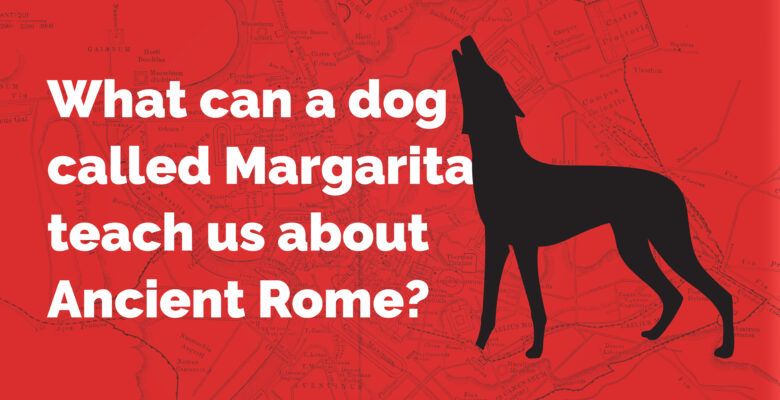What a dog called Margarita can teach us about Ancient Rome
The way in which we – as academics, students, or the general public – encounter Roman inscriptions today has very little to do with the way in which these inscribed monuments and objects were encountered, and made part of everyday life, in the ancient world.
This sensory disconnect, placed on top of linguistic divides, is relevant to all our senses, including the visual, and to our entire experience of the ancient world. After all, significantly more often than not, we do not encounter the ancient texts where they once belonged, and, at any rate, even if and when we do, the environment has changed significantly since ancient times.
All of this results in significant obstacles to any attempt for a genuine appreciation of ancient artefacts, especially when and where those inscriptions also contained poems – verbal art, after all, that was produced for a specific purpose, just as much as it was created for a specific context.
Do we do enough to enable current and future generations of those who are (or might be!) interested in the ancient world to comprehend and appreciate these messages from the Roman past?
Do we do enough to communicate this to students, teachers, and museum audiences?
Arguably not.
Not yet.
With generous financial support of the British Academy, as well as the very kind support of the British Museum (giving us access to their holdings for the purpose of our research), Dr María Limón (Universidad de Sevilla), Prof. Xavier Espluga (Universitat de Barcelona), and myself are hoping to effect a change for the better.
In collaboration with the Classics Department of the University of Reading, my former employer and María’s host institution during a BritAc-funded Visiting Fellowship, we proudly present a short educational film in which we explore the original sensory settings and complexities,but also explain our collective thinking as regards the ways in which we might re-imagine the lettered world of the Roman period in 21st century settings, from the classroom to the museum gallery.
Supported by the creative genius of James Rattee (find more of his work here), we explore the wide range of facets of what there is to learn from one – at first glance altogether unspectacular, easily overlooked – object, decontextualised and hidden in an almost sterile environment, once one begins to imagine its original setting, meaning, and use(s).
We use the beautifully instructive – and deeply moving – example of a verse inscription for a Roman dog called Margarita who died when giving birth (see the museum record here, explore the text on the Epigraphic Database Rome here, and feel free to read some further thoughts on this piece published some years ago on my personal blog):
Gallia me genuit, nomen mihi divitis undae
concha dedit, formae nominis aptus honos.
docta per incertas audax discurrere silvas
collibus hirsutas atque agitare feras
non gravibus vinc(u)lis unquam consueta teneri
verbera nec niveo corpore saeva pati:
molli namque sinu domini dominaeque iacebam
et noram in strato lassa cubare toro.
et plus quam licuit muto canis ore loquebar:
nulli latratus pertimuere meos.
sed iam fata subii partu iactata sinistro
quam nunc sub parvo marmore terra tegit.
Margarita.
Gaul sired me, the shell of the rich sea gave me my name: the honour of that name is becoming to my beauty. Taught to roam unexplored woodlands with courage and to chase hirsute game in the hills, unaccustomed ever to be restrained by heavy harnesses or to endure savage beatings with my snow-white body: for I used to lie in my master’s and my mistress’s lap and mastered the art of resting wearily on a spread-out blanket. Even though I used to be able to express more than I was entitled to with my inarticulate mouth – that of a dog! –, no one feared my barking. But I have already met my fate, stricken down during ill-omened whelping – me, whom earth now covers under this little marble plaque.
Margarita (‘Pearl’).
The highly entertaining 10-minutes film (if we do say so ourselves!) was officially released on the YouTube channel of Reading’s Classics Department last week: read our interview on occasion of the launch here.
We hope that you will find it entertaining and instructive.
We hope that it will be accessible to, and thus reach, audiences ranging from students and teachers in schools and universities to the general public, from those who wish to learn about ancient Rome (and Roman dogs) to those who write curricula, plan lessons, and – very importantly – communicate the ancient world to modern audiences in museums, collections, and in the media. (And we have included subtitles in several languages, to make this as widely accessible as possible!)
We hope to transform the way in which the Roman verse inscriptions are being perceived and employed, because it is precisely through texts like these that the ancient world speaks to us at its most eloquent and at its most moving. If we do not utilise this potential, we are missing a trick.
If you enjoyed the video, leave us a short message (or a comment/like on YouTube).
But even more importantly to us, whether you are a student, teacher, museum educator, collection manager, educationalist, policy maker who wants to know more or do more: do get in touch with us, formally or informally, at mappola(dot)erc(at)gmail(dot)com and let us enter a meaningful conversation about the ways in which we can reimagine the way in which we think and speak about the Roman world!
María, Xavi, and I – as well as all of us here at Team MAPPOLA – would love to hear from you!

